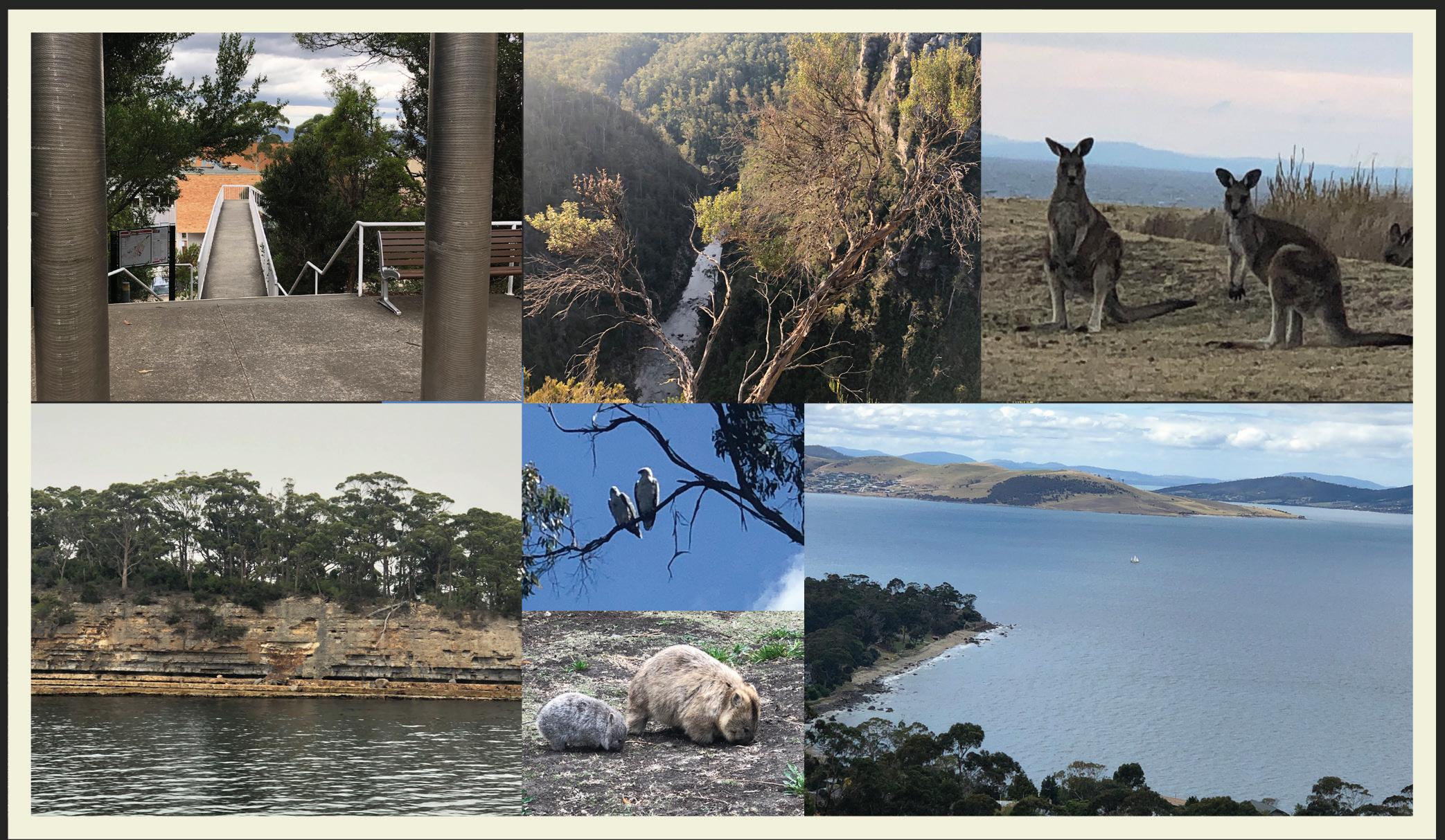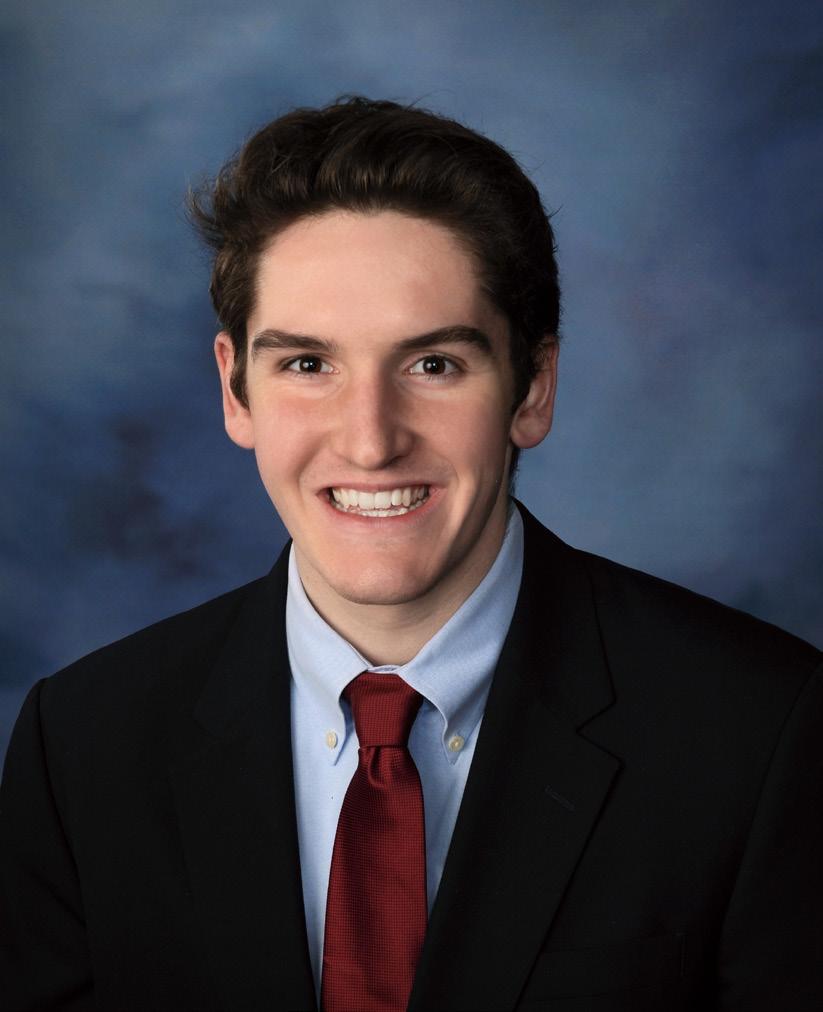
9 minute read
Evacuation Order
Dr Sue VandeWoude, 2020 Fulbright Future Scholar
I had been in Hobart, Tasmania, off Australia’s southern coast, for nearly two months on my first, and almost certainly my last, sabbatical. I had seen wombats, echidna, kookaburra, regularly heard the calls of forest ravens and cockatoos, and had visited a handful of local brewing establishments.
And, yes, I had also been at work. This included taking baby steps in learning statistical computing and graphics (R programming) and a set of mathematical modeling principles (structural equation modeling). Along the way I had become a fan of Sewall Wright, a population geneticist who had famously studied guinea pigs, and I had created a twocolor correlation graph with actual data that I had proudly shared with my adult children.
The goal of my sabbatical was to use these tools to understand a novel process by which a cat’s immune system could resist infection with feline immunodeficiency virus, or FIV. I hoped my findings would not only lead to new treatment options for cats with this disease, but, by analogy, guide novel ways to modify infections caused by the human disease correlate, HIV.
This One Health project – linking animal disease to its human analogue – could push my laboratory studies in a new direction. But on March 12, I received an unexpected notification from the U.S. Department of State advising “all current U.S. Fulbright participants to make arrangements to depart their country of assignment as soon as possible.”
Despite the growing pandemic pandemonium I had watched unfolding in news reports, it had not dawned on me that I might need to truncate my visit to the University of Tasmania, Australia, more than a month early. At that point, the small island state had very few confirmed cases of COVID-19 compared to countries coping with mounting catastrophe.
Sue VandeWoude learned about Tasmanian ecology and history. Scenes included, clockwise from top left: Churchill Avenue Overpass, University of Tasmania; Mersey River, near the town of Mole Creek, on ancestral lands of the Aboriginal people; Forester kangaroos on Maria Island; the mouth of River Derwent near Taroona; a mother wombat and joey on Maria Island; sea eagles at Arthur River; and Point Puer, site of a former British boys prison at Port Arthur. At right, VandeWoude is pictured near the campus of Colorado State University in Fort Collins, Colorado. Photo by Mary Neiberg
Flora and fauna were untouched by "

I had been poised to travel the next week to the University of Queensland and University of Sydney to visit veterinary colleagues working in the field of viral spillover and infectious disease.
I was looking forward to meeting with Edward Holmes, a virologist at the scientific center of the growing pandemic, who for years has predicted events that could lead to a global disease outbreak.
I was intending to ask Dr. Holmes about the practice and applications of One Health, the study of systemic problems that incorporate environmental, human, and animal considerations, using transdisciplinary approaches. The thoughts of this world expert on one of the most high-profile One Health topics – transmission of microbes from animals to humans when the environmental context favors rare events – would be of great assistance when I returned to Fort Collins at the end of my sabbatical to assume the role of director of the CSU One Health Institute. Yet, my visit was canceled by the most severe One Health crisis of our lifetime.
After receiving the State Department’s notice, I wrestled with the decision of whether to ride out the pandemic in a secluded spot about 3,600 miles north of Antarctica or endure a 30-plus hour trip through at least four airports during the exponential phase of SARS-CoV-2 spread.

Mount Wellington rises above Hobart, on the island state of Tasmania.
While considering my options, I biked and hiked along the River Derwent. Signs of the pandemic were virtually absent, other than hand sanitizer and social distancing behavior at the café.
Flora and fauna were reassuringly untouched by the spasm gripping the human world, and this added surreal features to the circumstances. Communications with family, interspersed with final trips to Hill Street Grocery and other favorite haunts, helped me realize I needed to wrap up my trip.
This decision was punctuated by announcements that Australia’s two primary airlines would be suspending all international flights. So with great inner sadness, I boarded a plane the next week in Hobart, and 30 hours later found myself back in Fort Collins.
The procedures in place at international terminals to intensify screening for COVID-19 consisted of collapsing each planeload of passengers into a small hallway to be asked individually if we had recently visited China. Given the number of passengers congregating through the small passageway – many of whom were wearing masks, some stifling coughs and sneezes – I spent my first two weeks in Fort Collins in self-isolation before transitioning home. How does it feel to be here? Nothing is the same, and everything is the same. It is spring, the house is dusty, birds are deep in preening activities. Vistas of Pacific bays and stands of eucalyptus are replaced with prairie and foothills and old cottonwoods. I can’t stop thinking about how extraordinarily lucky I am.
I have become immersed in COVID-19 research activities and preparations to advance the CSU One Health Institute as a powerhouse. I am convinced CSU can be an absolute leader in this area; we have a remarkable coalition of passionate faculty who thrive on rolling up their sleeves, being practical, and working together.
Yesterday, for the first time in weeks, I looked at a spreadsheet and prepared to import it into R studio. I thought about standard equation modeling.
I listened to the boreal chorus frogs and spotted a great horned owl. I reviewed the latest scientific findings about COVID-19 on bioRxiv and counted my blessings for living in a safe and secure environment.
I realized it is time for One Health.
By Dr Sue VandeWoude. Originally published in State.

Sue receives her Fulbright certificate from Australian Federal Education Minister, the Hon Dan Tehan in February 2020, mere weeks before COVID made social distance the new norm.
Global Citizenship Amid and After COVID-19
BY MARK CZEISLER
A mandatory evacuation from Australia cut Fulbright Scholar Mark Czeisler‘s exchange trip short, but rather than give up on his research plans, Mark decided that this was an opportunity to start a new collaboration to help evaluate the effectiveness and impacts of COVID mitigation strategies.
After World War II, Senator J William Fulbright sponsored legislation to establish a program for the “promotion of international good will through the exchange of students in the fields of education, culture, and science.” Since 1946, the Fulbright Program has supported nearly 400,000 scholars in 160 countries.
The Fulbright Program mission to improve cultural diplomacy and intercultural competence motivated me to travel to Australia as a Fulbright Scholar. I remember proudly applauding US firefighters volunteering to join Australian firefighters fighting devastating bushfires as I was boarding the 10,000-mile flight from Boston to Melbourne. I landed on January 24th, less than 24 hours before the first confirmed COVID-19 case in Australia. Like many, I soon realized the gravity of the emerging pandemic. The suffering across Italy forewarned nations worldwide of the rapid transmissibility and potency of the virulent disease. Among early responses by the US government, on March 19th Secretary of State Mike Pompeo suspended the US Fulbright Program globally and recalled all Scholars back to the US immediately.
Abruptly leaving Australia for the U.S. seemed counterintuitive, given the significantly lower prevalence of COVID-19 in Australia, and was disappointing given that I had just established myself in Melbourne. However, despite the harrowing 33-hour, 3-flight journey back to the US and into quarantine isolated from friends and family, I appreciated the support of my country.
After bringing citizens abroad home, nations worldwide have turned inward, restricting international travel. Absent widespread testing, effective treatments or vaccination, government and health officials have resorted to stringent mitigation strategies, causing massive disrupted socioeconomic, political, cultural,

Rising tensions have produced a myriad of demonstrations and retaliations ranging from protests to conspiracy theories and xenophobic, racist, and violent attacks. Xenophobia started toward people of Chinese and East Asian descent and has progressed to include hotspot European countries, even though the US now has and educational systems.
more cases than any other country. As the pandemic continues, balancing physical isolation while maintaining threads of global citizenship will be imperative.
Australia and New Zealand may serve as models for safely achieving transnational partnership. Both nations are on the brink of eradicating COVID-19, and assuming the last push of stringent mitigation strategies is effective in doing so, they plan to create a travel bubble between the two countries as they re-open.
The move, which would greatly benefit both economies and reinforce an alreadystrong transnational bond, could be something to consider once safe travel becomes possible. MARK CZEISLER , Fulbright Future Scholar (Medical Science/Harvard University)
However, a return to widespread global travel is unlikely in the short- or even medium-term, and creative strategies will be required to overcome xenophobic and nationalistic ideology. Recovering and strengthening international ties to meet the unprecedented pre-pandemic-era levels of economic, political, and cultural globalization in the absence of physical exchange will depend on reciprocal cooperation and mutual understanding of an important and overlooked reality: we are all on the same team in the fight against COVID-19. Senator Fulbright alluded to the value of this perspective in his book about American global engagement during the Cold War Era in The Price of Empire.
"The essence of intercultural education is the acquisition of empathy—the ability to see the world as others see it, and to allow for the possibility that others may see something we have failed to see, or may see it more accurately.
The simple purpose of the exchange program...is to erode the culturally rooted mistrust that sets nations against one another. The exchange program is not a panacea but an avenue of hope..."
- J William Fulbright Senator Fulbright’s perspective has inspired me to continue conducting research with my Australian supervisors despite global suspension of the Fulbright Program. We initiated an AustralianAmerican collaboration to study public support of COVID-19 mitigation strategies. International collaboration has enabled scientists separated by 10,000 miles to harness differences in COVID-19 prevalence, mitigation strategies, and cultural contexts to gain insights on the public response to this pandemic that transcend national borders.
Five months into the pandemic, there have been more than seven million confirmed cases and 400,000 deaths among 188 countries that have reported cases worldwide.
While facing inward to address the nations’ needs is crucial, Senator Fulbright’s message cannot be lost. Rather, in the absence of widespread physical exchange in the wake of the destruction and suffering caused by the COVID-19 pandemic, intercultural collaboration and empathy have never been more needed.
By Mark Czeisler









